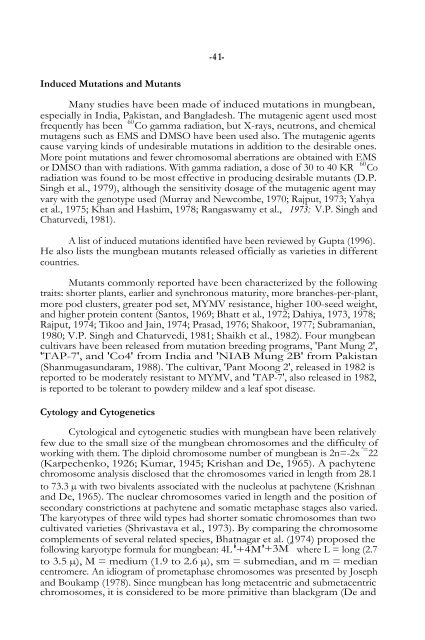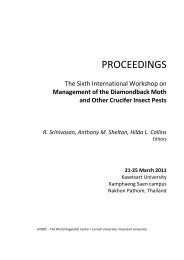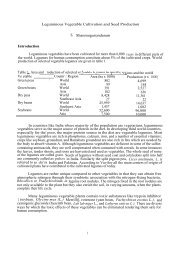MUNGBEAN VARIETAL IMPROVEMENT S. Shanmugasundaram
MUNGBEAN VARIETAL IMPROVEMENT S. Shanmugasundaram
MUNGBEAN VARIETAL IMPROVEMENT S. Shanmugasundaram
Create successful ePaper yourself
Turn your PDF publications into a flip-book with our unique Google optimized e-Paper software.
-4 1-<br />
Induced Mutations and Mutants<br />
Many studies have been made of induced mutations in mungbean,<br />
especially in India, Pakistan, and Bangladesh. The mutagenic agent used most<br />
frequently has been 60 Co gamma radiation, but X-rays, neutrons, and chemical<br />
mutagens such as EMS and DMSO have been used also. The mutagenic agents<br />
cause varying kinds of undesirable mutations in addition to the desirable ones.<br />
More point mutations and fewer chromosomal aberrations are obtained with EMS<br />
or DMSO than with radiations. With gamma radiation, a dose of 30 to 40 KR 60 Co<br />
radiation was found to be most effective in producing desirable mutants (D.P.<br />
Singh et al., 1979), although the sensitivity dosage of the mutagenic agent may<br />
vary with the genotype used (Murray and Newcombe, 1970; Rajput, 1973; Yahya<br />
et al., 1975; Khan and Hashim, 1978; Rangaswamy et al., 1973; V.P. Singh and<br />
Chaturvedi, 1981).<br />
A list of induced mutations identified have been reviewed by Gupta (1996).<br />
He also lists the mungbean mutants released officially as varieties in different<br />
countries.<br />
Mutants commonly reported have been characterized by the following<br />
traits: shorter plants, earlier and synchronous maturity, more branches-per-plant,<br />
more pod clusters, greater pod set, MYMV resistance, higher 100-seed weight,<br />
and higher protein content (Santos, 1969; Bhatt et al., 1972; Dahiya, 1973, 1978;<br />
Rajput, 1974; Tikoo and Jain, 1974; Prasad, 1976; Shakoor, 1977; Subramanian,<br />
1980; V.P. Singh and Chaturvedi, 1981; Shaikh et al., 1982). Four mungbean<br />
cultivars have been released from mutation breeding programs, 'Pant Mung 2',<br />
'TAP-7', and 'Co4' from India and 'NIAB Mung 2B' from Pakistan<br />
(<strong>Shanmugasundaram</strong>, 1988). The cultivar, 'Pant Moong 2', released in 1982 is<br />
reported to be moderately resistant to MYMV, and 'TAP-7', also released in 1982,<br />
is reported to be tolerant to powdery mildew and a leaf spot disease.<br />
Cytology and Cytogenetics<br />
Cytological and cytogenetic studies with mungbean have been relatively<br />
few due to the small size of the mungbean chromosomes and the difficulty of<br />
working with them. The diploid chromosome number of mungbean is 2n=-2x = 22<br />
(Karpechenko, 1926; Kumar, 1945; Krishan and De, 1965). A pachytene<br />
chromosome analysis disclosed that the chromosomes varied in length from 28.1<br />
to 73.3 µ with two bivalents associated with the nucleolus at pachytene (Krishnan<br />
and De, 1965). The nuclear chromosomes varied in length and the position of<br />
secondary constrictions at pachytene and somatic metaphase stages also varied.<br />
The karyotypes of three wild types had shorter somatic chromosomes than two<br />
cultivated varieties (Shrivastava et al., 1973). By comparing the chromosome<br />
complements of several related species, Bhatnagar et al. (1974) proposed the<br />
following karyotype formula for mungbean: 4L S '+4M s '+3M "' where L = long (2.7<br />
to 3.5 µ), M = medium (1.9 to 2.6 µ), sm = submedian, and m = median<br />
centromere. An idiogram of prometaphase chromosomes was presented by Joseph<br />
and Boukamp (1978). Since mungbean has long metacentric and submetacentric<br />
chromosomes, it is considered to be more primitive than blackgram (De and

















